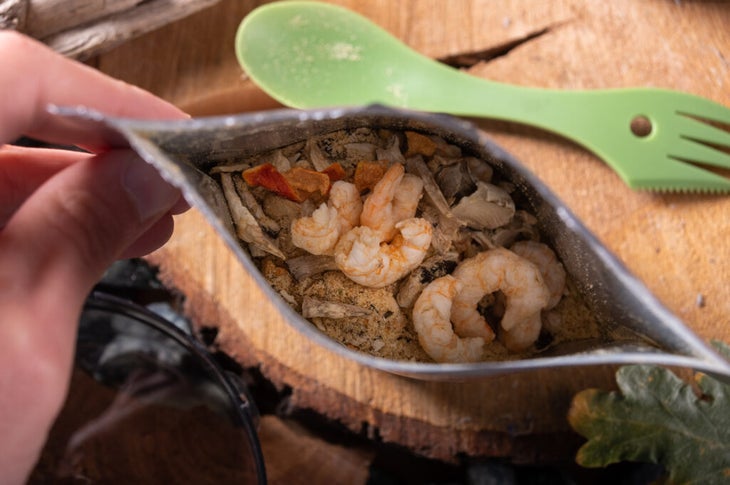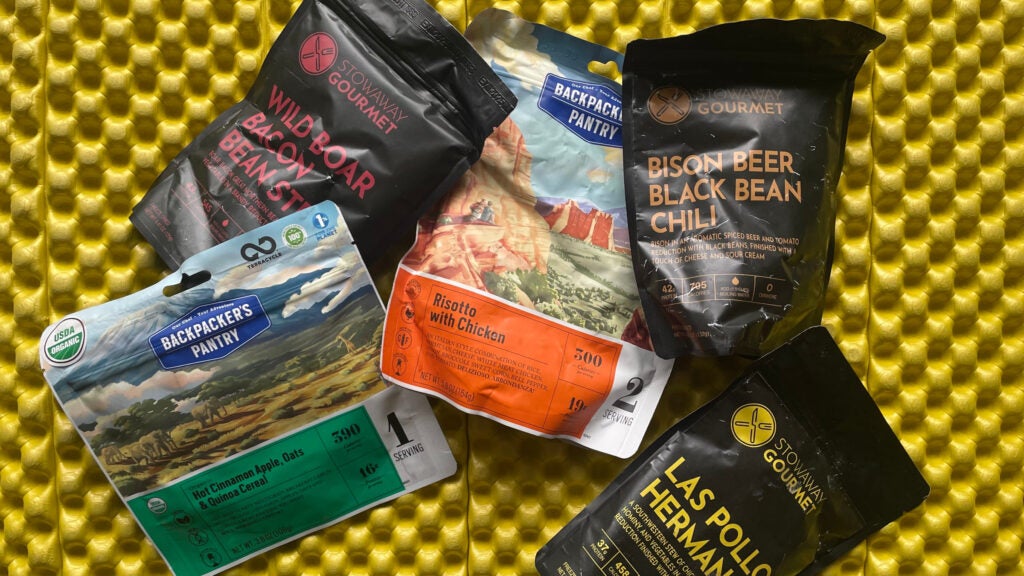“], “filter”: { “nextExceptions”: “img, blockquote, div”, “nextContainsExceptions”: “img, blockquote, a.btn, a.o-button”} }”>
Heading out the door? Read this article on the new Outside+ app available now on iOS devices for members!
>”,”name”:”in-content-cta”,”type”:”link”}}”>Download the app.
Dried, prepackaged meals are one of the greatest innovations of modern backpacking. Shelf-stable, commercial breakfasts and dinners allow hikers to cut down on both prep time and packweight, and many of them actually taste pretty good. Freeze-dried and dehydrated backpacking meals offer variety, nutritious ingredients, and pack a calorie punch without being bulky. Plus, it’s easy to keep a supply on hand so you can hit the trail at a moment’s notice—no meal planning required.
But how long do backpacking meals actually last? There’s a lot of conflicting information out there: Some freeze-dried meals are purported to last forever, while other camping dinners claim to go bad after a couple of years. In truth, the longevity of your backpacking food depends on a few different factors. We spoke to experts in the world of camping food to learn more.
Drying Method
The preservation technique used to make backpacking food has an impact on shelf life. The vast majority of commercial camping meals are freeze-dried. This process removes moisture from food by subjecting it to very low temperatures, low pressure, and then heat; as a result, moisture sublimates from the food. Freeze-dried foods often maintain their structure and rehydrate quickly. Dehydration, on the other hand, implements heat to dry out food.
Freeze-drying is slightly more effective at removing moisture, so freeze-dried meals tend to have a longer shelf life than dehydrated meals. But there are other benefits to opting for dehydrated foods: They’re often lower in volume, as food shrinks more when dehydrated than when freeze-dried. It’s easier (and cheaper) to dehydrate food at home than it is to freeze-dry. And, according to Good To-Go head chef and co-founder Jennifer Scism, dehydrated foods retain their original texture far better than their freeze-dried counterparts.
“Freeze-drying allows the peas to stay bright green and carrots their brilliant orange, but because of the process, the cell structure is compromised and when rehydrated, the vegetable will come back mushy,” Scism said. “Dehydrating requires a longer rehydration time, but I believe the textural benefits outweigh the few more minutes the diner has to wait for perfection.”
When determining the shelf life of your backpacking food, check whether it is freeze-dried or dehydrated. Common brands like Backpacker’s Pantry, Mountainhouse, and Backpacker favorite Stowaway Gourmet are freeze-dried and can last for decades under the right conditions. Select specialty brands like Good To-Go and Farm to Summit use dehydrated ingredients, and you may want to eat them within the first few years of purchase.
Ingredients
Even dried, some ingredients last longer than others. Dehydrated milk and nuts, for example, spoil faster than grains and vegetables. As a result, there’s no one-size-fits-all answer for how long backpacking food lasts.
“Fats tend to be the Achilles heel of freeze-dried food. Manufacturers generally have to choose between manufacturing for ultra-long shelf lives by minimizing fats, or for taste and nutrition by using nutritious fats,” said Dan West, founder of Stowaway Gourmet.
If you want to keep a cache of backpacking food on hand for a long time, Schism recommends stocking up on single ingredients rather than complete meals. Rice, quinoa, beans, and veggies are great contenders for a long shelf-life. “This way you don’t have to worry about losing a whole meal due to one ingredient that might go bad faster than the others,” she said.

Parsing Best-By Dates
Packaged foods are required to display a best-by date, but you shouldn’t necessarily treat this like an expiration date on perishable food.
“To determine that date, manufacturers generally rely on lab studies or on observations of food held in typical storage conditions for many years,” West said.
Lab studies simulate aging by subjecting packaged foods to increasing temperatures. For brands like Good To-Go, this process takes 20 weeks; if the food maintains its quality, the brand stamps it with a three-year shelf life. Manufacturers often repeat this process with old products, which allows them to extend best-by dates.
“We always retain a good amount of packaged meals from that first batch, and as years pass, we retest the aging meals,” said Scism. Good To-Go rechecks their meals in-house for flavor and consistency, and sends samples to a lab to test for things like PH, mold, and yeast.
“If there’s a thumbs up on all of the above, we will add an additional year for the shelf life. We repeat this yearly,” said Scism. “We do stop at six years. We believe real food shouldn’t last forever.”
That said, don’t take best-by dates as gospel. Dried food can last a very long time if properly sealed and stored.
Can I Eat “Expired” Backpacking Food
Since the best-by dates on dried food pouches don’t truly reflect expiration, it’s likely safe to eat beyond the printed date.
“Manufacturers are constantly extending their dates for certain products as they periodically taste test examples of their oldest products,” West said. “Generally, freeze-dried food is safe to eat after its official best-by date. As long as the packaging is intact, the food will be isolated from moisture and immune from microbial degradation.”
The same is generally true for dehydrated backpacking food. It’s OK to take best-by dates with a grain of salt, but rely on your senses to determine if food is still good to eat.
How to Tell if a Backpacking Meal is Spoiled
West recommends using taste and smell as your guides. You’ll likely notice a rancid smell if your backpacking meal has gone bad.
“If the food smells fine when you open the bag, it is probably OK,” he said. “The ultimate test is in the rehydration. Rehydrated food that tastes and smells fine is generally safe to eat.”
If you’ve had a stockpile of backpacking meals sitting in storage for years, it’s a good idea to give it a taste-test before packing for a trip. West said that once you open the pouch, it will oxidize fairly quickly, so be sure to eat or discard it soon after opening.
Proper Storage
“It is best to store freeze-dried food in dark, cool, dry conditions. Avoid storing your food in attics, garages, and other spaces subject to extreme temperatures,” said West.
Just like you would on the trail, be sure to safeguard your food from rodents at home. West said that microscopic food residue is common on the outside of backpacking food packaging—even these traces are enough to attract critters. Store your inventory of backpacking food in a hard-side container to help reduce the smell.
